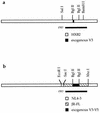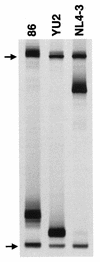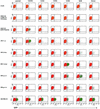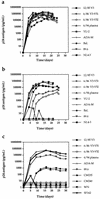Exclusive and persistent use of the entry coreceptor CXCR4 by human immunodeficiency virus type 1 from a subject homozygous for CCR5 delta32
- PMID: 9621067
- PMCID: PMC110409
- DOI: 10.1128/JVI.72.7.6040-6047.1998
Exclusive and persistent use of the entry coreceptor CXCR4 by human immunodeficiency virus type 1 from a subject homozygous for CCR5 delta32
Abstract
Individuals who are homozygous for the 32-bp deletion in the gene coding for the chemokine receptor and major human immunodeficiency virus type 1 (HIV-1) coreceptor CCR5 (CCR5 -/-) lack functional cell surface CCR5 molecules and are relatively resistant to HIV-1 infection. HIV-1 infection in CCR5 -/- individuals, although rare, has been increasingly documented. We now report that the viral quasispecies from one such individual throughout disease is homogenous, T cell line tropic, and phenotypically syncytium inducing (SI); exclusively uses CXCR4; and replicates well in CCR5 -/- primary T cells. The recently discovered coreceptors BOB and Bonzo are not used. Although early and persistent SI variants have been described in longitudinal studies, this is the first demonstration of exclusive and persistent CXCR4 usage. With the caveat that the earliest viruses available from this subject were from approximately 4 years following primary infection, these data suggest that HIV-1 infection can be mediated and persistently maintained by viruses which exclusively utilize CXCR4. The lack of evolution toward the available minor coreceptors in this subject underscores the dominant biological roles of the major coreceptors CCR5 and CXCR4. This and two similar subjects (R. Biti, R. Ffrench, J. Young, B. Bennetts, G. Stewart, and T. Liang, Nat. Med. 3:252-253, 1997; I. Theodoreu, L. Meyer, M. Magierowska, C. Katlama, and C. Rouzioux, Lancet 349:1219-1220, 1997) showed relatively rapid CD4+ T-cell declines despite average or low initial viral RNA load. Since viruses which use CXCR4 exclusively cannot infect macrophages, these data have implications for the relative infection of the T-cell compartment versus the macrophage compartment in vivo and for the development of CCR5-based therapeutics.
Figures




Similar articles
-
Chemokine coreceptor usage by diverse primary isolates of human immunodeficiency virus type 1.J Virol. 1998 Nov;72(11):9307-12. doi: 10.1128/JVI.72.11.9307-9312.1998. J Virol. 1998. PMID: 9765480 Free PMC article.
-
Role of CXCR4 in cell-cell fusion and infection of monocyte-derived macrophages by primary human immunodeficiency virus type 1 (HIV-1) strains: two distinct mechanisms of HIV-1 dual tropism.J Virol. 1999 Sep;73(9):7117-25. doi: 10.1128/JVI.73.9.7117-7125.1999. J Virol. 1999. PMID: 10438797 Free PMC article.
-
Coreceptor usage of primary human immunodeficiency virus type 1 isolates varies according to biological phenotype.J Virol. 1997 Oct;71(10):7478-87. doi: 10.1128/JVI.71.10.7478-7487.1997. J Virol. 1997. PMID: 9311827 Free PMC article.
-
HIV-1 infection in individuals with the CCR5-Delta32/Delta32 genotype: acquisition of syncytium-inducing virus at seroconversion.J Acquir Immune Defic Syndr. 2002 Mar 1;29(3):307-13. doi: 10.1097/00126334-200203010-00013. J Acquir Immune Defic Syndr. 2002. PMID: 11873082 Review.
-
CCR5 as a Coreceptor for Human Immunodeficiency Virus and Simian Immunodeficiency Viruses: A Prototypic Love-Hate Affair.Front Immunol. 2022 Jan 27;13:835994. doi: 10.3389/fimmu.2022.835994. eCollection 2022. Front Immunol. 2022. PMID: 35154162 Free PMC article. Review.
Cited by
-
No selection for CCR5 coreceptor usage during parenteral transmission of macrophagetropic syncytium-inducing human immunodeficiency virus type 1.J Virol. 2001 Sep;75(18):8848-53. doi: 10.1128/jvi.75.18.8848-8853.2001. J Virol. 2001. PMID: 11507230 Free PMC article.
-
Human immunodeficiency virus type 1 envelope-mediated neuronal death: uncoupling of viral replication and neurotoxicity.J Virol. 2003 Jun;77(12):6899-912. doi: 10.1128/jvi.77.12.6899-6912.2003. J Virol. 2003. PMID: 12768009 Free PMC article.
-
CCR5Delta32 59537-G/A promoter polymorphism is associated with low translational efficiency and the loss of CCR5Delta32 protective effects.J Virol. 2008 Mar;82(5):2418-26. doi: 10.1128/JVI.01596-07. Epub 2007 Dec 19. J Virol. 2008. PMID: 18094161 Free PMC article.
-
Metabolomics as an Approach to Characterise the Contrasting Roles of CCR5 in the Presence and Absence of Disease.Int J Mol Sci. 2020 Feb 21;21(4):1472. doi: 10.3390/ijms21041472. Int J Mol Sci. 2020. PMID: 32098198 Free PMC article. Review.
-
Genome-wide CRISPR/Cas9 screen reveals JunB downmodulation of HIV co-receptor CXCR4.Front Microbiol. 2024 May 20;15:1342444. doi: 10.3389/fmicb.2024.1342444. eCollection 2024. Front Microbiol. 2024. PMID: 38835488 Free PMC article.
References
-
- Alkhatib G, Combadiere C, Broder C C, Feng Y, Kennedy P E, Murphy P M, Berger E A. CC CKR5: a RANTES, MIP-1α, MIP-1β receptor as a fusion cofactor for macrophage-tropic HIV-1. Science. 1996;272:1955–1958. - PubMed
-
- Alkhatib G, Liao F, Berger E A, Farber J M, Peden K W C. A new SIV co-receptor, STRL33. Nature. 1997;388:238. - PubMed
-
- Atchison R E, Gosling J, Monteclaro F S, Franci C, Digilio L, Charo I F, Goldsmith M A. Multiple extracellular elements of CCR5 and HIV-1 entry: dissociation from response to chemokines. Science. 1996;274:1924–1926. - PubMed
-
- Balotta C, Bagnarelli P, Violin M, Ridolfo A L, Zhou D, Berlusconi A, Corvasce S, Corbellino M, Clementi M, Clerici M, Moroni M, Galli M. Homozygous Δ32 deletion of the CCR-5 chemokine receptor gene in an HIV-1-infected patient. AIDS. 1997;11:F67–F71. - PubMed
Publication types
MeSH terms
Substances
Associated data
- Actions
- Actions
- Actions
- Actions
- Actions
- Actions
- Actions
- Actions
- Actions
- Actions
- Actions
Grants and funding
LinkOut - more resources
Full Text Sources
Other Literature Sources
Medical
Molecular Biology Databases
Research Materials

